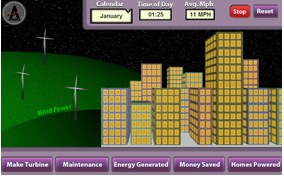Wind Power

In 2010, only 2.3% of the electricity generated in the United States was produced by wind power. Scientists and environmentalists suggest that percentage should be upped to 20% by the year 2030. To do so will require advances in the design and maintenance of wind turbines. Your challenge is to investigate the factors that maximize the efficiency of the operation and maintenance of a wind turbine. This is one assignment that you shouldn't "blow off."
What are renewable energy sources?
Renewable energy is energy from natural resources that can be naturally replenished. In other words, a source of energy is considered renewable if it can be replaced at the same rate or faster than it is used, within a reasonable timeframe. Some renewable energy sources include sunlight, wind, rain, tides, and geothermal heat. Also, biofuel is fuel from biomass, which is made from biological material that originated from living organisms or organisms that have recently died. Some sources of energy that are non-renewable include nuclear power and fossil fuels, like coal and oil.How is most electricity in the United States generated?
In 2009, 44.9% of the electricity produced in the United States was generated from the burning of coal, 23.4% from natural gas, 20.3% from nuclear power, 6.9% was from conventional hydroelectric energy, 1% from petroleum, and only 3.6% from other renewable sources of energy. Coal now accounts for more than half of the electricity production in the United States. Coal is relatively cheap, depending on how it is burned. It ranges in cost between $94.80 per megawatt hour and $136.20 per megawatt hour. Natural gas costs between $63.10 and $124.50 per megawatt hour. Natural gas is also the fastest growing source of electrical energy in the United States. Nuclear power costs $113.90 per megawatt hour. Conventional hydroelectric power costs $86.40 per megawatt hour. Wind power costs about $97.00 per megawatt hour, but if generated off shore costs $243.20 per megawatt hour. Wind power, if generated on site can be one of the cheapest energy sources, but if generated offshore of a country, it can be the most expensive source of energy.Which factors impact the efficiency of a wind turbine?
There is no perfectly efficient way to convert energy. There are many factors that affect wind turbine efficiency. The aerodynamic properties of a turbine's blade allow it to move in a way that the wind is used in the correct direction. The directions of the blades allow it to use the maximum amount of wind without minimizing the range of wind bearings that it can use to generate electricity. The blades must be able to withstand physical forces such as gravity and dynamic interactions. The condition of the gears and such in the turbine must be good in order to minimize friction and energy lost to heat. Location is essential for the efficiency of a wind turbine because it is reliant on, you guessed it, wind! If the location does not have very reliable wind to use, then the cost effectiveness of the turbine is largely decreased.How are wind turbines maintained?
Wind turbines, like all mechanical constructions require maintenance. Inside most wind turbines, there is a rope access for maintenance crews to inspect the turbine. Some preventative maintenance procedures include gearbox oil changing, turbine blade cleaning, and monitoring the tension of the bolts in the tower. These procedures can keep a gearbox from failing. The gearbox is possibly the most expensive part of a wind turbine to replace. To replace a gearbox or a blade, a large crane would be necessary, as well as transportation for the parts to and from the area.How does a wind turbine produce electricity?
To produce electricity, the wind turbine acts as a converter. The kind of energy in wind is kinetic energy from the motion of the air molecules. The molecules have kinetic energy and collide with the blades of the turbine, causing them to turn. This is the process of using kinetic energy to generate mechanical energy. The blades are connected to gears within the turbine that turn to rotate either a magnet around a copper wire coil, or the coil around magnet. This rotation creates a magnetic field that generates electric flow in the wire. The set up of the wire and the magnet is called an alternator.Walkthrough
You need to log in to access this simulation.



